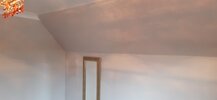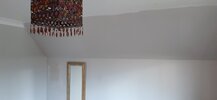Hi, I'm not even sure of the terminology here so bear with me!
I'm going to wallpaper a feature wall in our bedroom which slopes into the eaves i.e. it's a normal straight vertical wall for the first 175cm or so then it slopes out towards you as you look at it to join on to the ceiling for another 45 cm or so. My wife refers to it as a coombe wall (??).
Anyway, I was wondering what the advice would be for papering this as I'm going to paper the angled, sloping bit as well as the usual vertical face. Like an idiot I have of course bought patterned wallpaper where the matching will be tricky. I suppose there are 2 choices basically: 1) try to hang single lengths or 2) cut, then hang each strip in 2 sections (sloping bit then vertical) where I would have to try to match horizontally (at the cut) as well as the usual vertical match.
Any advice would be really welcome, apologies if I've not explained it very well!
Steve
I'm going to wallpaper a feature wall in our bedroom which slopes into the eaves i.e. it's a normal straight vertical wall for the first 175cm or so then it slopes out towards you as you look at it to join on to the ceiling for another 45 cm or so. My wife refers to it as a coombe wall (??).
Anyway, I was wondering what the advice would be for papering this as I'm going to paper the angled, sloping bit as well as the usual vertical face. Like an idiot I have of course bought patterned wallpaper where the matching will be tricky. I suppose there are 2 choices basically: 1) try to hang single lengths or 2) cut, then hang each strip in 2 sections (sloping bit then vertical) where I would have to try to match horizontally (at the cut) as well as the usual vertical match.
Any advice would be really welcome, apologies if I've not explained it very well!
Steve



